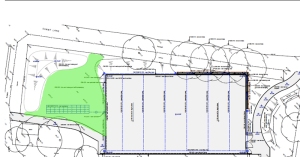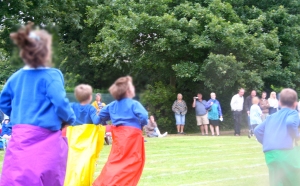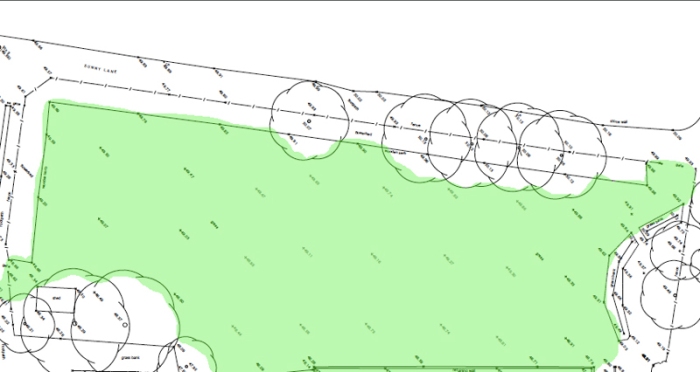King Charles school field and why it’s worth saving
If you have kids at King Charles, or live nearby and see the children enjoying their free time on the school field, you’ll know how much it means for them to be able to run and play on this little oasis of green space. So you may have been surprised to find out about plans to tarmac over the bulk of the field and cut down four oak trees along its border in order to create a so-called ‘MUGA’ (multi-use games area). You may also have been shocked at the way these plans came to light, and by the fact that parents and local residents had not been consulted about this major change to the school environment. This leaflet has been produced by a group of concerned parents. We believe that the field is an exceptionally valuable feature of the school for this and future generations of children.
If you agree that the field should not be destroyed in this way, we hope you’ll join us in making your views known to the school and to Cornwall Council – before it’s too late.
Why is play in a green, natural environment so vital for children’s well-being?
Recent research indicates that:
Children who play regularly in natural environments show more advanced motor fitness, including coordination, balance and agility, and are sick less often. Children with symptoms of Attention Deficit Hyperactivity Disorder (ADHD) are better able to concentrate after contact with nature. When children play in natural environments, their play is more diverse, with imaginative and creative play that fosters language and collaborative skills. Children in contact with nature score higher on tests of concentration and self-discipline. Nature buffers the impact of life stress on children and helps them deal with adversity. The greater the amount of nature exposure, the greater the benefits. Play in a diverse natural environment can help reduce bullying.
The plan to replace the field and trees with a multi-use games area ignores the fact that that it already is just such an area – but also so much more. It’s impossible to square this plan with the school’s claim that it is “acutely aware of its responsibility to the natural environment and to ensuring a sustainable future for the natural world”.
The school field – before and after:
No amount of cosmetic shrubbery or “natural borders” can hide the fact that a beautiful, natural field will be destroyed by the development.
The second drawing, which forms part of the planning application, shows the oak trees along the top of the field unchanged. But it’s clear from the rest of the application that they would in fact be felled. They could not be replaced with new trees, as their roots might damage the tarmac surface of the MUGA. A letter to parents from the school on 1st July 2010 states that the surface of the m.u.g.a will be a “green specialist surface” suitable for children. It may in fact be green in colour, but here the resemblance to the grass field will stop.
Playground injuries: grass vs tarmac
Medical research into playground injuries has found that falls onto tarmac are nearly four times more likely to result in injury than falls onto grass.
Where are we now, and what happens next?
At a Falmouth Town Council Planning Committee meeting on 28 June, a King Charles parent and a local resident outlined their objections to the plan. Several other objections had also been sent via email. The Committee expressed its surprise that parents and residents had not been consulted by this late stage. It also recommended that the views of the Conservation Area Officer and the Tree Officer be sought before the plans were taken any further.
But this does not mean that the plan will be shelved. Nor does the fact that funds may not currently be available mean that the plan will not be put into effect later on, if the application is approved in principle.
To protect the field for our children and for the future, it’s vital
that people who value this green space make their views known.
Please send an email by 5 July to the Cornwall Council Planning Department, planning.central1@cornwall.gov.uk, quoting application number PA02/0512/10/G, or write to them at: Planning Department, Cornwall Council, Circuit House, Pydar Street, Truro, TR1 1GT
Don’t let King Charles school field go the same way as so many of the green spaces that children used to enjoy.
Once it’s gone, it’s gone.
To enable parents to share views and get updates on the school field, keep visiting the blog at:
https://kcschoolparents.wordpress.com
email us at: kcschoolparents@virginmedia.com
If you are really motivated please download the leaflet below, print out and give to a parent or resident!
HRH Prince William has been invested with the task of stopping playing fields across the UK from being sold off and concreted over.
Prince William has become the figurehead of a campaign to save hundreds of playing fields in honour of the Queen’s diamond jubilee in 2012. His patronage of the Queen Elizabeth II Fields Challenge is a personal tribute to his grandmother, said his private secretary Jamie Lowther-Pinkerton. The project is the first major initiative involving a member of the royal family that has been announced to mark the Queen’s 60 years on the throne.
The charity Fields in Trust will run the initiative which aims to safeguard and help create more than a thousand playing fields within the next two years. The prince said: “Playing fields are not a luxury. They are a vital component of any healthy and happy community.”
Prince William’s conviction is that green spaces are key to happy local communities: they provide venues for sports, children playing or just neighbourhood get-togethers. Playing fields provide a setting for a huge range of activities that strengthen family and community bonds. These places to bring communities together and to transform lives, the life of the community itself and the lives of the people living in it.
See:
also see:
Playing in this soft, natural environment, something loved by children at KC, is threatened by the proposed plans
The proposed plans will remove the possibility for these sports activities. If the plans are not challenged our children’s play and fun in this soft, natural environment will be replaced by a hard tarmac fenced in court. Access to the sensory garden will be restricted. The trees above the parents in the photo will all be felled. Lunchtime free play on the field, something our children adore, will be stopped. The field is an integral part of our children’s learning, well being and happiness at KC. Parents and children need to have a forum for discussing the implications of the proposed plans. The School has not discussed this with parents yet these plans have the potential to affect the well-being and happiness of future generations of children at King Charles.
Plans have been submitted to tarmac the school field at KC
Plans have been submitted to tarmac over 50% of the school field at KC. This has been met by sadness and bewilderment by children and parents at KC. Many parents have been told that funding has been lost for the proposed plans. This may be the case, however, the loss of funding does not stop the planning process.
If the plans get passed the children and community of Falmouth will loose the field for ever.
Nick Clegg: ‘we must save school fields’
As part of a series of interviews with the main political party leaders, School Reporters from Harrogate Grammar School questioned Liberal Democrat leader Nick Clegg. They asked for his views about how secondary school places are allocated, the higher age of compulsory schooling and how he’d spend £1 million.
One of Clegg’s main issues was to campaign to stop the sale or development of school fields. How would he spend £1 million pounds?….yes he’d save a school field! Click on image to play.
Create Your Own Outdoor Classroom – The Whys of Outdoor Classrooms

1. High Retention Rate –
Hands on experience is one of the reasons that teachers are bringing their classes outdoors. At least 90% of the learning outdoors is a hands on experience. In a study done by Bethel Learning Institute, it was found that the retention rate is 75% for learning by doing. It goes up to 90% when students teach other students what they learned. Compared to lecture at 5%, learning by doing is a clear winner.
2. Empowerment –

Giving to the earth is powerful for students. Whether helping plant a tree, studying an insect, or preparing a garden for winter; students become connected to the earth. That connection empowers them through a sense of achievement and wonder. In turn it motivates them to want to do more, indeed building the foundation for respect.
3. Academics –
Math, science, social studies, art, language arts all come alive using nature as a learning lab. Nature is relevant learning at its best! Parents and community members can help you carry out these lessons. By drawing your community to the school, learning intensifies for students and the community.
4. Teamwork –

Learning teamwork is more accessible in “real life” or “natural” surroundings. Communication and the ability to work together is essential through out our lives. When you go outdoors with students, your class needs to establish a structure that will be safe for them and the equipment that they are using. If you have your class help set the safety rules and consequences, it makes classroom management everyone’s responsibility.
The school field facilitates all of the above.
for more details see http://www.outdoorclassroom.org/train.htm
Plans have been submitted to tarmac the school field at KC
Plans have been submitted to the council, by King Charles school, to make a tarmac sports area. The proposal is to build the tarmac sports area on the existing school field. As listed below in the other posts there is compelling evidence why this should not occur. The most important thing is to discuss this, but to date the school has not encouraged this. In a letter to parents today they suggest that 50% of the field will be lost yet below are the plans which show that it will far more than this. Arguing over the degree of loss ignores the fact that the children at the school adore playing in the field, many parents chose the school because of the field – it is a really special space, and there is masses of evidence supporting the educational benefit of free play in nature and in fields.
Buildings and grounds translate into improved staff morale, improved pupil behaviour and standards, and an improved school environment.
By 2020 the government would like all schools buildings and grounds to be regarded as living, learning places where pupils see what a sustainable lifestyle means through their involvement in the continual improvement of the school estate.
A sustainable school, including buildings and grounds, provides an excellent teaching and learning resource for staff and pupils. Sustainable design principles, sustainable technologies, sustainable interior furnishings and sustainable environmental management provide a living working example of sustainable living.
The management of the school estate, buildings and grounds, reflects how much it values and recognises pupils’ needs. Good design in both areas can translate into improved staff morale, improved pupil behaviour and standards, and an improved school environment.
Curriculum
Schools can use the curriculum to cultivate the knowledge, values and skills needed to appreciate the link between the built environment, human well-being and nature, and reinforce this through positive activities in the school and local area.
Campus
Schools can review the way their estate influences the behaviour, well-being and learning of pupils and staff, and take steps to enhance interior and exterior spaces for health, achievement and play, and to provide safe habitats for local wildlife.
Community Schools can use their communications, services, contracts and partnerships to promote the importance of sustainable design and practices in buildings and grounds among their stakeholders
Children who have contact with nature and green play work better in the classroom and had higher levels of flexibility and strength
New research has shown that learning in the outdoors improves concentration. Kathleen Bagot, who has recently completed her PhD at Monash University in Melbourne says “Evidence shows that if children are surrounded with lots of natural elements and grassy spaces, they will be able to refresh… more efficiently and effectively and improve their strength much quicker than children who stayed inside”. Her 5 year study examined 500 children from across Melbourne, comparing the motor co-ordination, strength, mathmatical ability and flexibility of children who played in forest-like environments compared to those who played in asphalt ones. “The results were clear that children who had contact with nature and green play worked better in the classroom and had higher levels of flexibility and strength”.
Reported in Sydney Morning Herald:
http://www.smh.com.au/national/education/learning-comes-naturally-for-some-20100123-mrnw.html
Research shows benefits of outdoor play and the importance of increasing physical activity in natural places
Research shows benefits of outdoor play
A new report entitled ‘Nature, Childhood, Health and Life Pathways’ has been produced by the University of Essex and reviews recent research and other statistical evidence proving the benefits of physical exercise in nature in improving health and wellbeing:
“Some of the substantial mental health challenges facing society and physical challenges arising from modern diets and sedentary lifestyles could be addressed by increasing physical activity in natural places. If children are encouraged to and enabled to undertake more green exercise then they are likely to have active exposure to nature embedded in their lifestyle as adults and will reap the associated health benefits”
Recommendations include:
– Encourage schools to incoporate use of gardens, allotments and woodlands as a regular part of the curriculum
– Evaluate the outcomes of outdoor play and green education on the cognitive capacities of children and their long term health.
Download the report here:
http://www.essex.ac.uk/ces/occasionalpapers/Nature%20Childhood%20and%20Health%20iCES%20Occ%20Paper%202009-2%20FINAL.pdf








